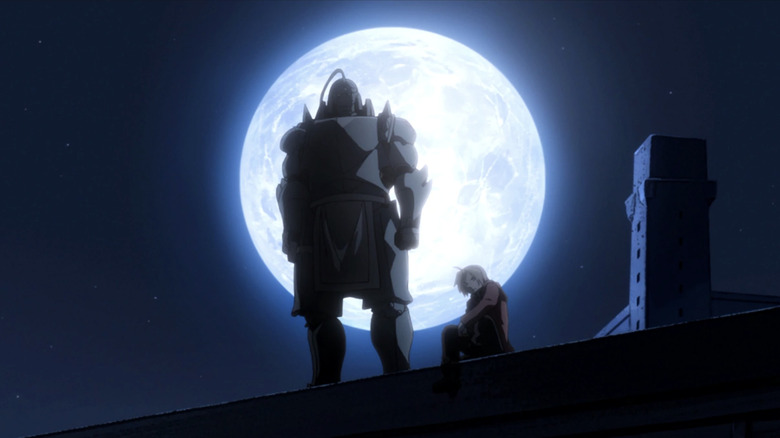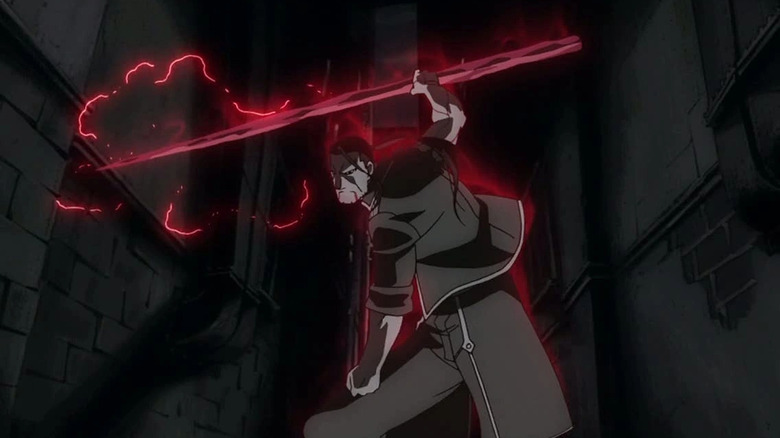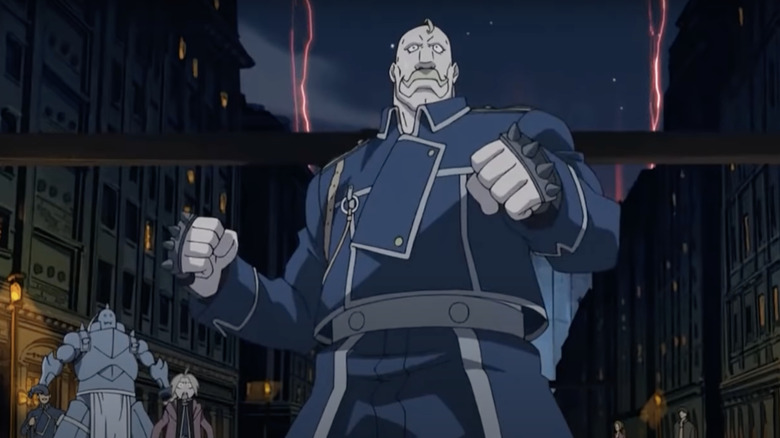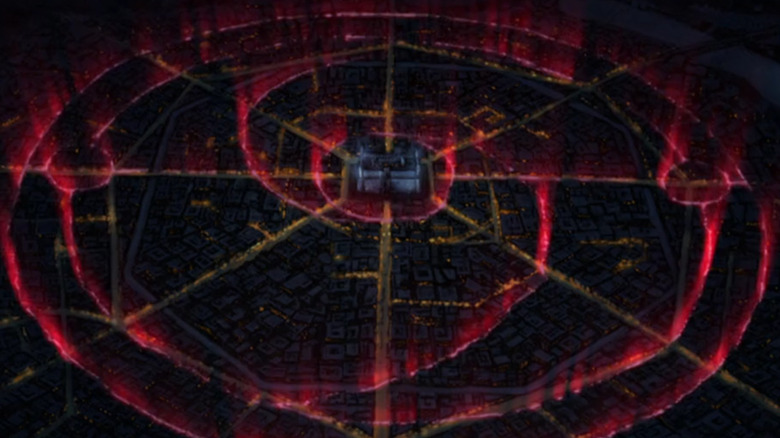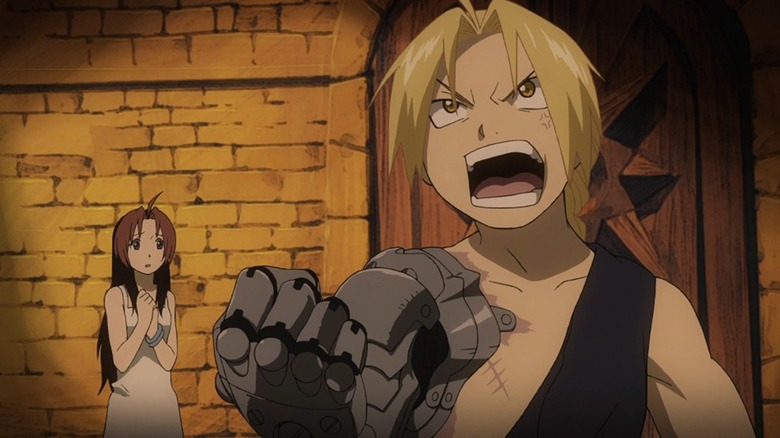How Fullmetal Alchemist: Brotherhood Created An Original Villain For Its First Episode
Rule of thumb: if a manga is moderately successful, odds are it'll get an anime adaptation. Some mangas are even lucky enough to be adapted more than once; one such series is Hiromu Arakawa's "Fullmetal Alchemist." The story, in all its variations, is about Edward Elric, aka the Fullmetal Alchemist, and his brother Alphonse. The Elrics are both alchemy prodigies, but their attempt to revive their mother backfired; Ed lost an arm and leg while Al's soul was bonded to a suit of armor. They now seek a mythical elixir called the Philosopher's Stone to regain their bodies.
The second anime, "Fullmetal Alchemist: Brotherhood," is renowned for its fidelity to the source material, compared to the first anime which wrote an original conclusion to make up for the then-incomplete manga. That's not to say "Brotherhood" is a one-to-one, panel-for-panel adaptation, though. One of the biggest changes is its first episode, an entirely original story featuring an anime-exclusive villain. Let's delve into this premiere and its ramifications.
Who is Isaac McDougal?
The villain of "Brotherhood" episode 1 (eponymously titled "Fullmetal Alchemist") is Isaac McDougal, aka the Freezing Alchemist. In Amestris, the Western Europe-styled nation where "FMA" is set, alchemists can become State Alchemists, "dogs of military" in exchange for exorbitant research grants and privileges. McDougal was one of these State Alchemists, his title being because his alchemy is based around transmuting water. He resigned his commission after the State Alchemists were forced to annihilate the nation Ishval.
By "Brotherhood" episode 1, McDougal has become a fugitive, drawing alchemic transmutation circles around Amestris' capital of Central City. Convinced the corrupt military must be destroyed for its war crimes in Ishval, his goal is to destroy the city with a tidal wave of ice and assassinate Führer King Bradley. Bradley assigns Col. Roy Mustang, the Flame Alchemist, to capture McDougal. Mustang in turn delegates the task to the Elric brothers.
The brothers grow interested in McDougal because he wields a Philosopher's Stone, but don't learn how he got it before he activates his transmutation circles. The Elrics defeat him before he can flatten the city with ice, so McDougal turns his alchemy inward, shaping his own blood into weapons. While he escapes the Elrics, he's not so lucky against Bradley.
So, why did "Brotherhood" choose to kick off with an anime-exclusive story? Well for one, it's an action-packed beginning that fits the pacing of the series. However, above all, the goal of the episode is to streamline the narrative.
Early character introductions
Let's compare the early progression of "Fullmetal Alchemist." The manga begins with a two-part story where the Elric brothers visit the city Liore and expose the false prophet Cornello. What follows are two one-off chapters, "The Mining Town" and "Battle on the Train."
After its original episode 1, "Brotherhood" uses its second episode for flashbacks showing how the Elric brothers got to where they are in episode 1 (in the manga, these flashbacks were saved until chapters 21-24). The anime then tells a compressed version of the Liore story in episode 3 before skipping over chapters 3 and 4. The stories finally match pace in chapter 5, or episode 4, "An Alchemist's Anguish."
Col. Roy Mustang and his subordinates (most prominently Lt. Riza Hawkeye) debut in chapter 4 of the manga. At the chapter's end, Mustang helps the Elrics foil the train hijackers, showing off his flame alchemy. Lt. Colonel Maes Hughes and Major Alex Louis Armstrong then debut in chapter 6, hunting the Ishvalan serial killer Scar. Readers meet Hughes' wife Gracia and his daughter Elicia in chapter 14, then Führer Bradley in chapter 15. In contrast, all these characters get introduced at once in episode 1 of "Brotherhood."
The episode also has a scene where McDougal tries and fails to recruit the imprisoned Crimson Alchemist, Solf Kimblee. This gives "Brotherhood" viewers an early taste of a villain who, like in the manga, won't come into play until much later.
"Brotherhood" episode 1 ends with the introduction of the Homunculi, Lust & Gluttony; it's implied Lust was the one who gave McDougal the Philosopher's Stone. In the manga, this pair debuts at the end of chapter 2. While this isn't that abridged of an introduction, it highlights the other purpose of episode 1: foreshadowing for the series' endgame.
Foreshadowing of the endgame
As "Fullmetal Alchemist" goes on, it's revealed that the Amestrian government is a front. Führer Bradley is the Homunculus Wrath and all of his top generals are in on a scheme masterminded by the first Homunculus, aka Father. Their plan is to transmute the souls of Amestris' population into a Philosopher's Stone, so that Father may breach the gate of Heaven, absorb God, and bestow his co-conspirators with immortality. Amestris' circular border is because the country is a giant transmutation circle.
McDougal's plan foreshadows this. The characters conclude he was simply driven mad with PTSD by the bloodshed of Ishval, but this wasn't the case. No, McDougal learned of Father's plan and was trying to stop it; he even aped his enemy's strategy of transmuting across a population center. One moment stands out in hindsight; McDougal asks Ed and Al, "Do you know the shape this country's in?" When Ed learns the truth in episode 35, he recalls McDougal's question and realizes the Freezing Alchemist was speaking literally.
This brings us to the final early character introduction in "Brotherhood" episode 1. When McDougal activates the ice blocks, the scene cuts to an extreme close-up of golden eyes opening. When he's foiled, these same eyes shut. It's later revealed these eyes belonged to Father, who dwells beneath Central City.
So, why did Lust give McDougal the Stone? For Father's plan, he needs five alchemists who've survived human transmutation (like the Elric brothers) to act as catalysts for his own nationwide transmutation. Lust was hoping McDougal could become one of these five.
Trade-offs of a new beginning
So, was the change worth it? Well, on its own terms, "Brotherhood" episode 1 is a decent outing with some nice action, comedy bits, and music — the deployment of "Lapis Philosophorum" in the climax is especially good. McDougal is also well-drawn for a one-off villain; his water-manipulating power is an inventive type of alchemy that the manga never depicted. The episode also accomplishes its goal of connecting the dots of the story from the beginning, but that very goal came with trade-offs.
The early chapters of "Fullmetal Alchemist" are the most formulaic, but since the Elrics were searching far and wide for the Philosopher's Stone, it makes sense they'd have such standalone adventures. Aside from episode 3, "City of Heresy," "Brotherhood" doesn't really have those sorts of episodes. Speaking of, Liore's impact is lessened by delaying it. In the manga chapters 1 and 2, Ed's robotic limbs and Al's lack of a human body are twists revealed when they face Cornello. Those moments, particularly Ed unsheathing his long coat to reveal his arm, lose their weight since viewers already know what happened to Ed and Al.
Episode 1 of "Brotherhood" wouldn't be the last time the series changed some details from the manga. Skipping "The Mining Town" meant the loss of the introduction of the supporting character Yoki and a chance to show Ed's trickster side. Episode 30, "The Ishvalan War of Extermination," also condenses a whole volume of the manga into one episode.
That said, this is definitely not the first adaptation, or even the first anime, to change details. What's important is how it captures the core of the story. On that test, "Fullmetal Alchemist: Brotherhood" passes with flying colors.
